I like Vital Lacerda’s games: Kanban EV is still one of my all time favourites, I previously wrote about Inventions: Evolution of Ideas, and by now I was fortunate to have either played or owned most of his big box titles. One that unfortunately hadn’t struck a cord with me was the fan-favourite The Gallerist, a worker placement game set in the art world that had an interesting twist: if another player wanted to use an action space you were in, they’d bump you out and you get what almost felt like a free turn as a conciliation price.
Now—as with Bot Factory and Mercado de Lisboa—Lacerda has once again taken inspiration from one of his prior games (the aforementioned The Gallerist), teamed up with a mate (João Quintela Martins), and distilled it down to a more easy going experience. To top things off, they’ve set it in the charming world of Portuguese restaurant musicians and garnered it in artwork that I can only describe as “endearing”. A recipe for success? Let’s see …

Setup
Setup in House of Fado is pretty smooth. On the main board, a selection of musicians is placed at the top, a number of grey, black, and brown patrons are thrown in a bag and then drawn from said bag to fill the streets with potential customers. Song tiles are shuffled, a few laid out on display, and finally three end game scoring tiles are randomly associated with the three different types of musicians in the game: Portuguese guitar, singer, and classical guitar.
Each player gets a player board, some wooden cubes to block off their reputation track, a large cardboard piece to lay over the largest table in their restaurant (which can be unlocked later), and receive 3 worker meeples. Oh yeah, they also get 5 coins each, a measly budget to start a restaurant on. That’s it. Yes, there are a few musician and song tiles to be sorted out based on player count, but it’s so few that it’s done in no time. So from opening the box with that inviting cover until you’re ready to play is just a few minutes … not counting the quite substantial rules teach of course.
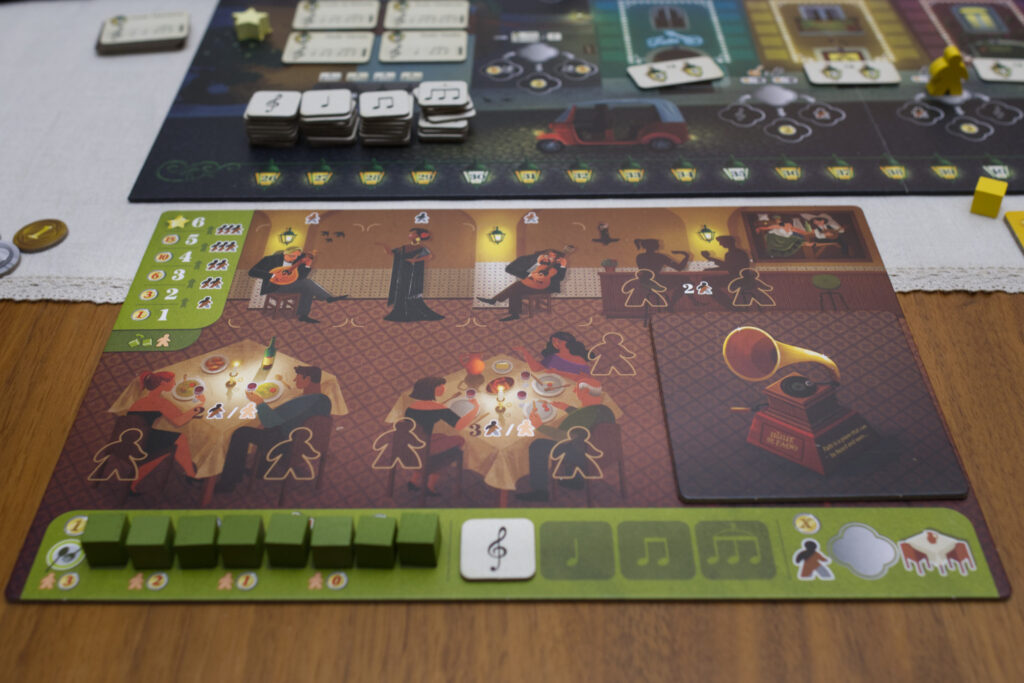
The Turn
When it’s a player’s turn, they take one of their workers on the board (or one of the those still off the board during the first three rounds of the game) and move it to a new location. Each action spot (except for the one in one’s own restaurant) functions in the same way: by placing a worker, the player executes the location’s action. But before that happens, they check if another player is already in that spot and if so bump them out of their spot. The pushed out player can choose one of three possible spill-over spots, each of which provides a small bonus such as getting a single coin or new patron to place at their restaurant’s bar. The important part here—especially in comparison to The Gallerist—is they are all simple, quick to do things that don’t break the flow of the game. It’s more a case of “oh, I got bumped? Great! I’d love to take that extra coin please.” In general, a player wants to take an action without providing any opponent such a bonus while on their own move meeples off locations nobody is interested in while keeping those glued to the board that are in places where another player will want to go.
So far, so simple. But how are all those possible actions connected and why should one choose one over the other?

The In-Game Economy: Money vs Fame
Looking at the larger economy, there are four entangled but separate elements going on: first, there is money. Money is needed to hire musicians and earned by first getting patrons into your restaurant, then urging them to pay the bill and vacate the tables. Musicians on the other hand are recruited for your restaurant so the patrons can applaud them before they leave and thus increase the musicians’ reputation (as indicated by some lovely stylised dice) which can then be turned directly or indirectly into victory points. Then there are cardboard tokens showing one or more notes which can be converted into song tiles, another potential source of VP. And finally there are five stars on the board, awarded to the first player that achieves a certain milestone.
Rather than explaining the rules in details, I’d like to talk you through the busy and stressful life of a restaurant entrepreneur as depicted in House of Fado. So let’s assume your restaurant is empty. You have no musicians and no guests, but still a little bit of money. Getting guests is easy: simply go to one of the two actions and pick up as many as you can fit onto a single of your tables. At the start, that’s either 2 or 3, and later in the game a 4-guest table can be unlocked. The colour of guest doesn’t matter here, they all pay the same, which is an amount based on the reputation of your restaurant. Every time a player gains reputation, they remove one cube from their reputation track and upon hitting certain levels, guests will start paying more and more money for their meals.

Converting guests to money is easy, just trigger the respective action on the player board. The guests will pay, leave, and when the bag runs dry be thrown back into it and eventually be back in the streets looking for new culinary adventures. There is a special type of meeple representing a food critic which can’t just be picked up but needs to be payed for. They require a table all to themselves and worse, they even don’t pay for their food. The only reason to bribe … aah … persuade them is to more easily get reputation as they will remove two of those reputation cubes at once before leaving. Reaching a certain level of reputation unlocks that third table and makes it easier to earn even more money. Reaching maximum reputation awards one of those star achievements. So far, so easy. Get guests, maybe a critic to get reputation up, higher reputation more money, done. The thing is: money converts pretty poorly into VP. It’s just a means to an end in a game where it’s all about the music.
So let’s look at the musicians instead. One thing is clear: you’ll need money to hire them. Looking at your restaurant, there is just one slot for each type of musician, meaning you can’t for example hire two singers at the same time. Each musician costs a flat fee to hire plus an additional amount of coins based on their popularity. By default all musicians start with a popularity of one and it only goes up. So once they get more famous and are back on the market, you might be able to hire more popular ones at an increased price. But how does a musician become popular? By being in a restaurant when the guests pay their bills and applaud. This is where the colour of meeple comes into play. Brown guests like to hear guitars, black ones are there for the singer, and grey don’t care, they just want to hear music. When a player triggers their restaurant action, each guest can be used to applaud a particular musician. For each level that their popularity is supposed to go up, 1-3 “compatible” guests are needed (i.e. brown and grey for guitarists, black and grey for singers). The musician’s die increases and from that point on they have that new level of popularity.
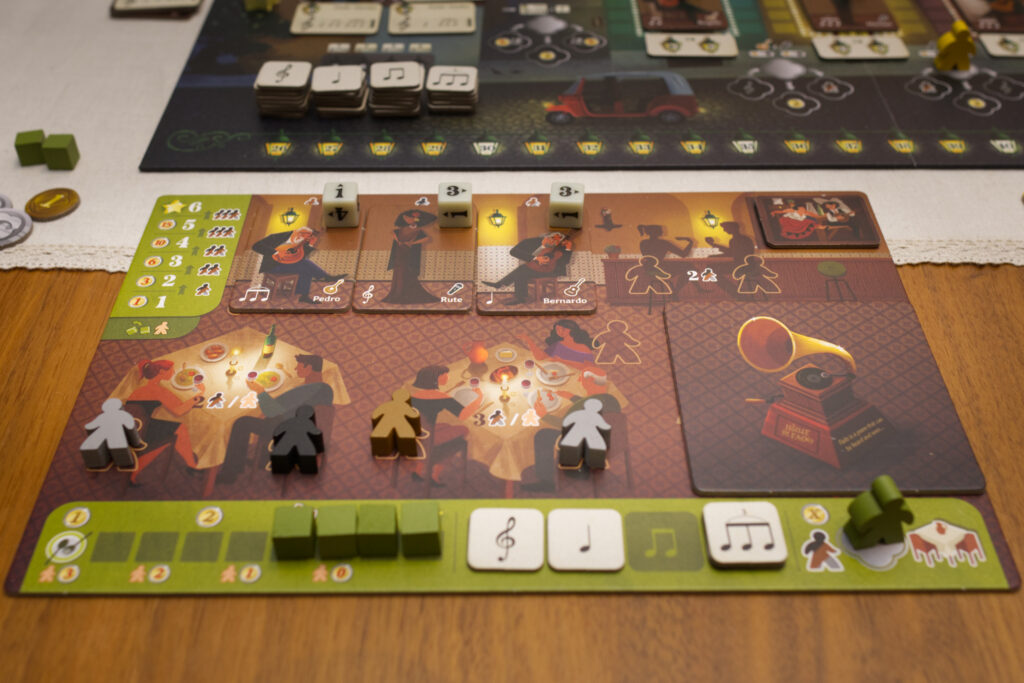
Popularity can be used for there things: the easiest is to release a musician from your service and gain VP equal to their level of popularity. This is mostly done to free up slots and pick up other musicians again. If a musician reaches the maximum level of popularity (=6), they become world famous and are automatically moved to a special location on the board. Not only does that player receive 6 VP but also one of those achievement stars for having produced the first world star of that type of musician. We’ll see why stars are important later on.
The most likely thing players will want to do with musicians is to promote them. On the main board, there can be one poster on a wall for each type of musician and placing one of your musicians there allows you to remove a reputation cube and place it next to the poster. This is the area majority element of the game as whoever has the most cubes in there at the end of the game will get points according to those scoring tiles that were placed there during setup. To do so can get challenging quickly as players are only allowed to replace a musician that’s already there if their own musician has a higher reputation. Players can recruit musicians right off the posters to free up the slot (and gain a high-level musician that might be easier to promote to that level 6 stardom) but have to be careful doing so because it opens up an opportunity for all players to sneak in and put their musician into the vacant spot first.

The final element to explain here are the compositions. This is a set-collection element where each tile shows a clef and then two or three patterns of notes (a quarter note, two eight notes, or a triplet). The required tiles can be picked up by hiring musicians (each has a symbol printed on them showing which type of tile is earned when hiring that musician) or on some “bump out” spots. If a player has the necessary tiles together, they can go to the rehearsal room action spot and convert them into the matching song tile and score 3-7 VP. Songs also give extra VP at the end of the game depending on how many songs they finished and whoever manages to compose three songs first gains one of those lucrative stars.
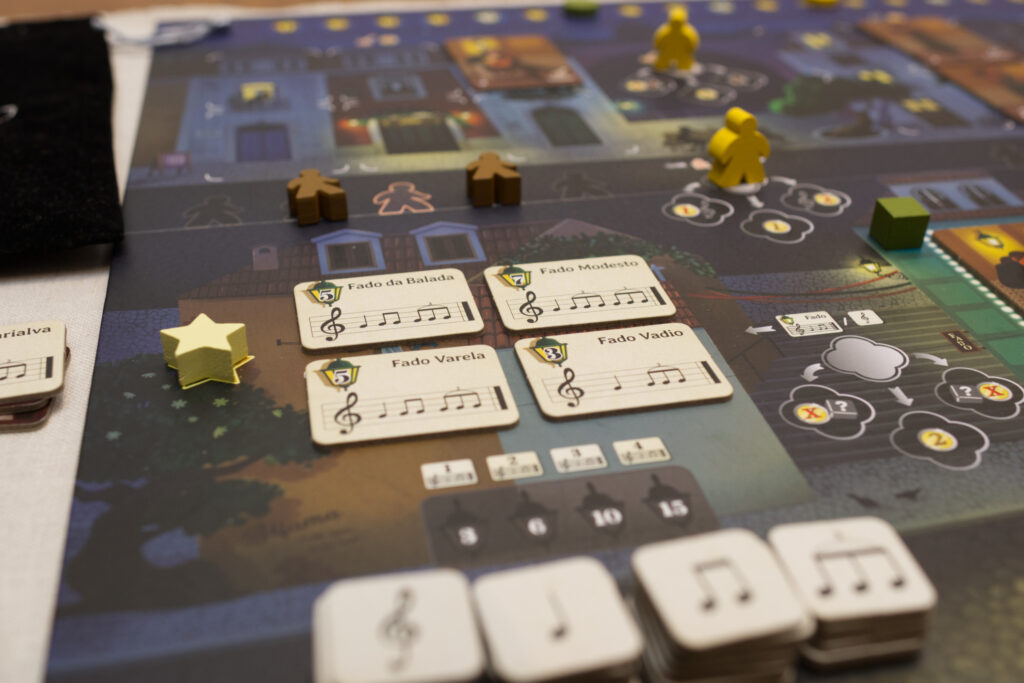
Game End
Speaking of stars: The game ends once the third overall star has been awarded. Note there is no “play one more round”, only the current round is completed. This makes the end of House of Fado sneak up on players, despite there being no hidden information in there.
To tally up the score, 1VP is awarded per 5 coins, any musicians remaining in restaurants can be let go for VP equal to their popularity, bonus points are awarded the more stars and the more completed songs a player owns, and finally the majority in cubes at those posters is awarded VP based on the scoring tiles underneath them. That’s it, most VP wins.
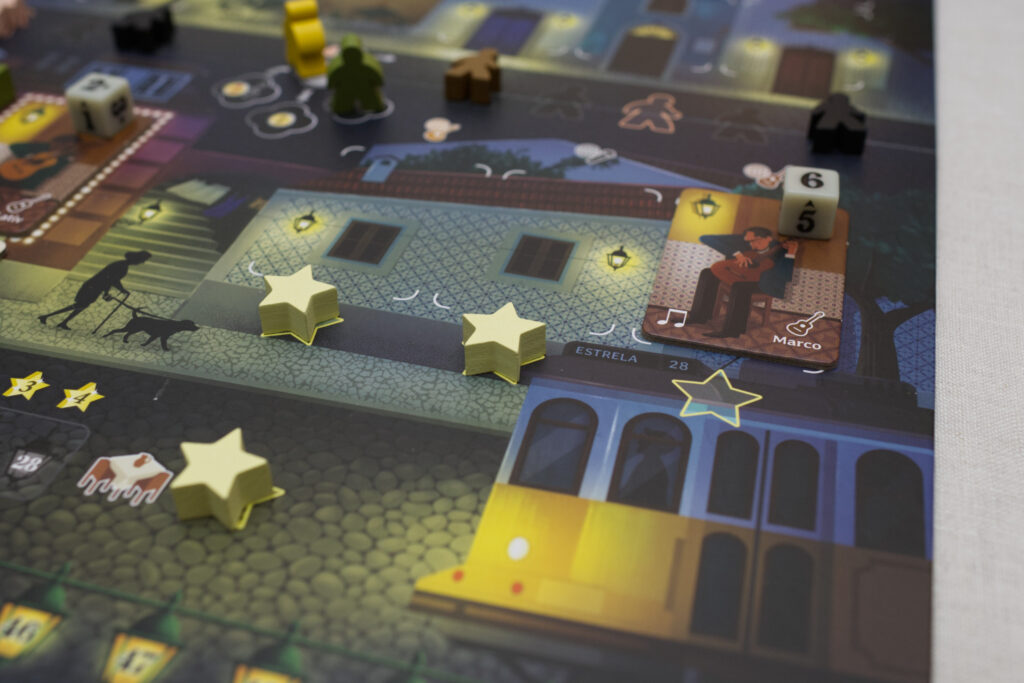
Solo Mode & Player Count
House of Fado comes with an included solo mode that uses no extra components. Basically the automa always uses the meeple that’s next in clockwise order from where the human player performed their last action. So it has a bit of a puzzle feel as the human player can anticipate what the automa’s response to a particular move will be. Otherwise the automa benefits from some simplifications to make it more competitive, such as in it never having to pay coins, it doesn’t have to collect specific note tiles but uses universal jokers instead, musicians gain popularity in a slightly different way, and so on. Overall I would say it is quite tastefully done and evokes the experience of the multiplayer game. Initially, it felt me to me like the automa was a bit too easy until I realised I had played some small rules tweaks incorrectly. By now I can beat it pretty consistently, but I do have to pay attention to what I’m doing!
As a 2p game, House of Fado works nicely. But the more players there are, the more chaos—and as a consequence more fun— ensues. With lower player counts, it can quickly feel like there are standard openings and not much variety in the game because there is so little variety in the initial setup. However, after multiple turns and many small decisions, there is usually some interesting new situation coming up.
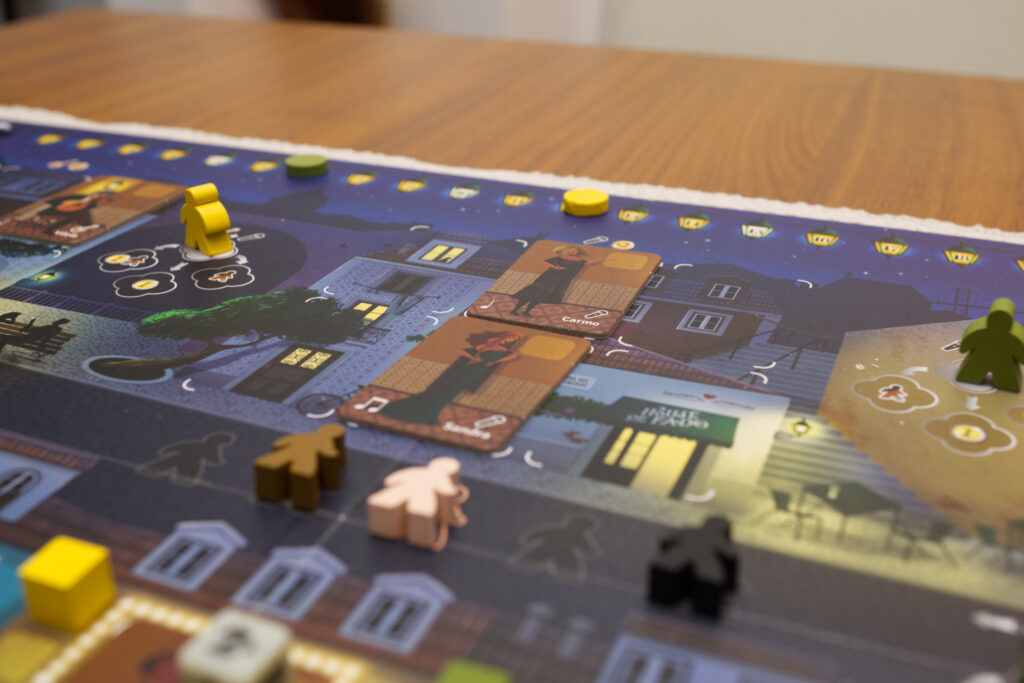
Variants & Kickstarter Extras
As part of the Kickstarter version, two optional modules were included in the box. One is a set of three smaller meeples per player colour which are intended for use in 2p games. The “assistants” can be left behind when moving a normal meeple off an action spot without having been bumped. If they themselves get bumped, the player still gets the bonus of the spill-over spot of their choosing. It makes the two player experience a bit more lively because you more often get some small bonus here and there, but overall it didn’t change the 2p experience dramatically in my experience. So a nice to have, but not essential. Still, I’ll use these for every 2p game I play from now on.
The other module comes in the form of three special musicians (representing the two designers and artist of House of Fado) which do not provide a note token when being hired but some special bonus. I haven’t had a chance to play with them yet, but again, my assumption is it’s a nice to have but not essential.
Otherwise the start player token comes in special wooden version and I would expect the bag not to have House of Fado stitched on it in the retail edition. Overall though, you’re completely fine to get the retail version of this game unless you plan to only play 2p and want those extra meeples.
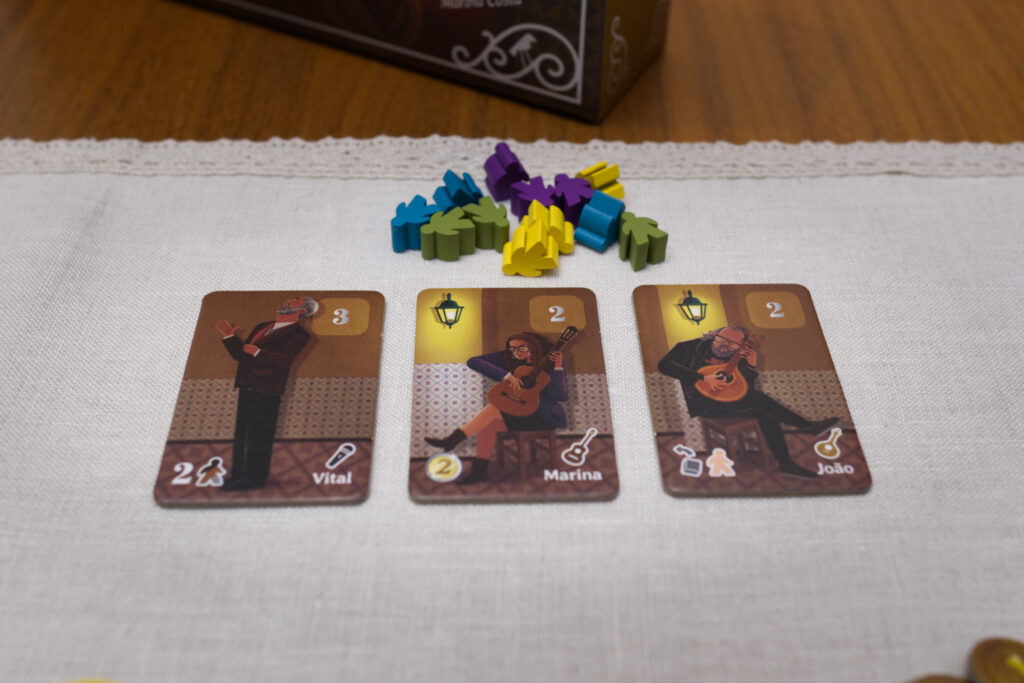
Conclusion
I had been a bit unsure about House of Fado when its campaign ran, mostly because of the lukewarm reviews of Mercado de Lisboa and Bot Factory I had read. But that theme and art had made me curious and so when the opportunity came up to purchase someone else’s copy, I went for it and am glad I did. This game is just charming. I like that it hits this sweet spot where it isn’t trivial to play, you do have to plan your moves, but I can do so after a long day at work or when playing with casual players. The artwork is inviting and the bumping-action produces nice positive incentives to stay engaged even if it is not your own turn. I would even go so far as to say I like it more here than in The Gallerist because it doesn’t break the flow of the game as much, is simple to do, yet consequential enough that you’ll want to avoid triggering it for an opponent if you can do so. Take for example the “gain one coin” spill-out action. It doesn’t sound like much, but especially during the early stages of the game, that single coin can make the difference between being able to hire an extra critic or not or getting one more musician.
What feels a bit off to me thematically is that musicians neither help the restaurant earn more money nor attract more customers, or at least only indirectly so by removing one reputation cube if a musician gets promoted. There’s also no bonus for having a full band or something like that, turning the restaurant from a business to merely a stage on which the musicians can gain popularity. You don’t need three musicians, a single one will do just fine as long as you can get all guests to applaud for it and not waste potential popularity. As a result, I sometimes found myself just hiring musicians for their note token or because I could, not for their own merits. These are the moments where the theme takes a step back and the tight, mechanical optimisation puzzle pokes through a bit. But don’t get me wrong though! It’s still a fun puzzle to solve.
Overall, House of Fado has been a pleasant surprise for me, from the lovely theme and art to the nice production and solid gameplay. It lately has become my go-to for “let’s play something fun without too much stress or thinking required”. I’m doubtful though that House of Fado will find many fans. It is in this weird spot of being rather expansive (60-70€) for what it is, yet not as addictive or varied as some other light-to-mid-weight games (e.g. a Harmonies). Personally, I like this part of the hobby, games like Galileo Galilei or Messina 1347 that are just smooth, nicely produced, and enjoyable. Games where one notices the polishing and refinement the designers have done. But all too often, players will rather go for the remarkable rather than the unspectacular. In that regard, House of Fado would have benefitted from something that keeps drawing players in, that “I have to play that again” thing. The first act of the game feels almost scripted with only few key decisions to make (go for critic or not? Which musician to pick up first? What’s the best composition tile to aim for?) and it takes a bit for players to appreciate the small nuances during those early turns. A few more elements that shake up the initial setup from game to game could have been already it. Instead, House of Fado seems to rather go for that elegant type of timeless design where variability comes purely from player interaction, not from extra components … which works here better for 3-4 players than for two or solo.
At its current price point though, I have a bit of a hard time recommending House of Fado. The production is great, I for example love those stylised dice and some other smaller touches. But is there enough game to buy it instead of one of many other alternatives in the same price range? That’s for you to decide. I’ve grown quite fond of House of Fado and it will stay in my collection … which for those that know how aggressive I cull says a lot! It plays well, it is charming, it scales nicely. I’m always happy to play it, but it will have to be seen how often I’ll be pulling it off the shelf now that I’ve finished writing this review. It feels like I have seen what it can do and I appreciate it for it, but not more. Maybe someone will come up with a couple scenarios or solo challenges to play through? That would be nice! I really hope House of Fado will find it’s audience, because after all, one thing is beyond doubt: this is a damn charming game …
